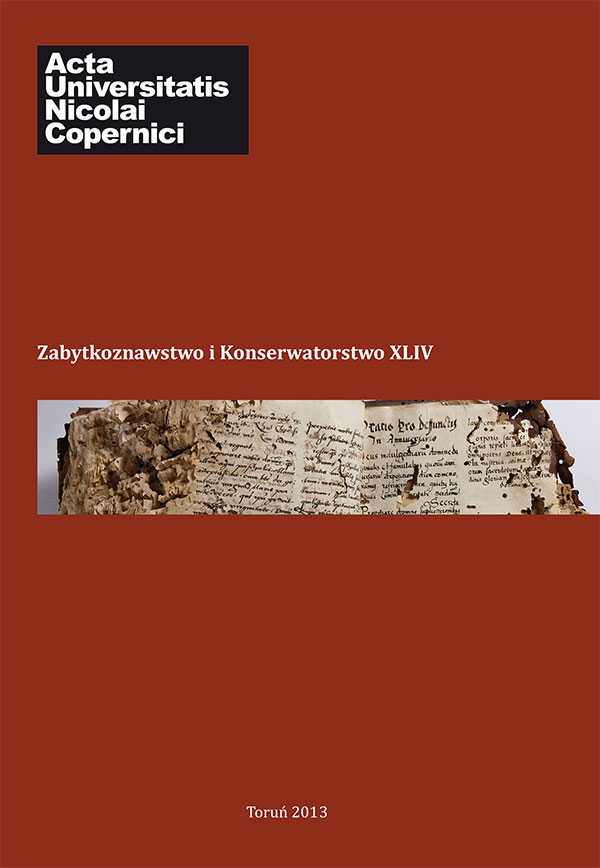Wprowadzenie do problematyki polichromii rzeźb i detali architektonicznych z tzw. sztucznego kamienia w sztuce państwa zakonnego w Prusach
DOI:
https://doi.org/10.12775/AUNC_ZiK.2013.002Słowa kluczowe
Prusy, polichromia sztucznego kamieniaAbstrakt
The issue of colouring in stone sculpture is not a new question in the studies on art, but recent decades have been marked with significant increase of this research current, including studies on technology and conservation works. Interdisciplinary projects of that type have been conducted both in the sphere of monuments of the Antique (the studies of V. Brinkmann, the Bunte Götter project), and in the sphere of mediaeval sculpture – mostly monumental one (the cathedrals of Senlis, Amiens; research and conservation of the sculptures in Magdeburg, Naumburg, Bamberg as well as the churches in South Germany).
This research announcement aims for pointing out to this issues regarding the sculpture made of the so called artificial stone in the Monastic State of the Teutonic Knights in Prussia. The research on the polychrome of 14th century sculpture and architectonic details made of this material for several years accompanies conservation – restoration and didactic activities carried out in the Institute for the Study, Conservation and Restoration of Cultural Heritage NCU. The resulting conclusions are very important for the theoretical studies on the art of the region, referring not only the issue of the complete aesthetic impact of those works, but contributing also to the issue of their workshop tradition. The investigation carried out on several artefacts from Teutonic castles in Toruń and Malbork revealed quite restricted colour palette of the polychrome (vermilion and lead white for flesh colour, black for the borders, gold-leaf) and a layer of minium as the bottom-most layer common for the most of them. That layer most probably was a priming, levelling the irregularities of the base, serving also as an underpainting. The comparative analysis revealed that this method was deeply rooted in the Western practice of 13th and 14th centuries on German territories. Its employment in Prussia contradicts the theory of the locally active workshops having developed specific painting techniques for the so called artificial stone. At the present stage of studies it can not be decided, whether the limited colouring of the subsequent polychrome layer proves developing an individual, modest aesthetics for the sculpture in the Monastic State (corresponding with the brick material of the architecture) or whether their final colouring also followed the Western patterns, but due to the poor state of preservation one deals with the incomplete and not entirely authentic image. This question seems attractive enough to launch a future inter-field research project aiming for answering it.
Pobrania
Opublikowane
Jak cytować
Numer
Dział
Licencja
CC BY-ND 4.0. Posiadaczem prawa autorskiego (Licencjodawcą) jest Autor, który na mocy umowy licencyjnej udziela nieodpłatnie prawa do eksploatacji dzieła na polach wskazanych w umowie.
- Licencjodawca udziela Licencjobiorcy licencji niewyłącznej na korzystanie z Utworu/przedmiotu prawa pokrewnego w następujących polach eksploatacji: a) utrwalanie Utworu/przedmiotu prawa pokrewnego; b) reprodukowanie (zwielokrotnienie) Utworu/przedmiotu prawa pokrewnego drukiem i techniką cyfrową (e-book, audiobook); c) wprowadzania do obrotu egzemplarzy zwielokrotnionego Utworu/przedmiotu prawa pokrewnego; d) wprowadzenie Utworu/przedmiotu prawa pokrewnego do pamięci komputera; e) rozpowszechnianie utworu w wersji elektronicznej w formule open access na licencji Creative Commons (CC BY-ND 4.0) poprzez platformę cyfrową Wydawnictwa Naukowego UMK oraz repozytorium UMK.
- Korzystanie przez Licencjobiorcę z utrwalonego Utworu ww. polach nie jest ograniczone czasowo ilościowo i terytorialnie.
- Licencjodawca udziela Licencjobiorcy licencji do Utworu/przedmiotu prawa pokrewnego nieodpłatnie na czas nieokreślony
PEŁEN TEKST UMOWY LICENCYJNEJ >>
Statystyki
Liczba wyświetleń i pobrań: 700
Liczba cytowań: 0



